Employee Innovation
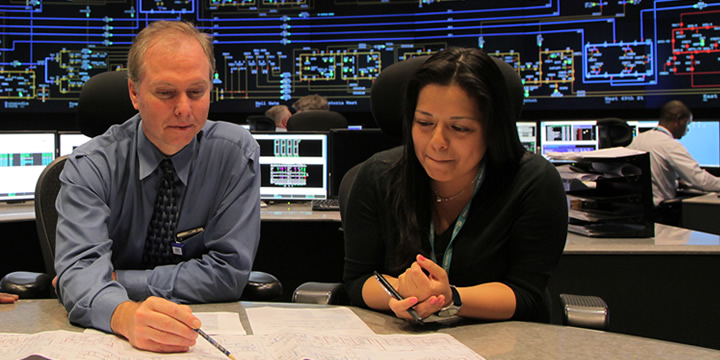
Committed participation at all levels, from the executive officer through the entry-level employee, is essential in working toward an injury-free workplace. Con Edison has made gains in establishing a strong safety culture that encourages employees to internalize the corporate commitment to safety and apply it every day on every job.
As a result of their personal commitment to safety, many Con Edison employees, working singly or in teams, introduce significant innovations that can be applied company-wide. These initiatives substantially reduce safety risks associated with recurring work, or common tasks. Some employee-developed technologies are so distinctive that they are awarded patents, and in certain cases, the methods and technical innovations draw interest from other utility companies nationwide. A brief review of some safety enhancements introduced by employees during 2012 demonstrates the real-world experience that individuals and teams harness to keep colleagues throughout the organization safer on the job.
Cable cutting-head holder
Con Edison of New York electric operations crews at times come across active secondary faults in underground structures. The company’s current engineering specifications don’t allow employees to enter an underground facility that's experiencing an active secondary fault. The fault has to be isolated first, and this is done by cutting the associated cable.
Traditionally, employees made that cut with an improvised tool. They used a heavy tape wrap to fasten a cutting head to a wooden stick, then used this to reach down into the underground space to sever the cable. Members of a cross-functional team recognized the problem with this “rough-and-ready” approach. If the tape let go, the cutting head could fall in the hole and be difficult to retrieve, especially with an active fault condition. The stick being used might be too short, too long, or too flimsy.
Members of this team wanted to develop a better alternative. They designed and developed a new cutting-head holder. This item holds the head firmly and consistently. It won’t let the head fall in the hole, and it also functions as a cable grabber. Using this new tool makes a demanding job much safer for the employees performing the work. It is easy to use, and can be deployed quickly, which is a real advantage during an active fault. It is also a good example of how this team identified a problem, worked out a solution, and brought it to the field where it could help colleagues throughout the company work more safely.
Meter-disconnect adapter
Disconnecting electrical services at customer premises is a common job, and this team developed a way to make it safer. Until recently, disconnecting power at a customer's premises could involve a number of mechanisms that would interrupt electrical services at the meter socket while the meter remained in place. Because of the variety of meters and meter sockets in use throughout Con Edison of New York’s service territory, field personnel often had to carry many different types of hardware to work with different equipment varieties.
Once the customer’s service was restored, the gear used to interrupt power was removed, but it had the potential to loosen meter socket jaws, creating a so-called hot-socket condition. If this happened, the meter pan could overheat, creating a potential safety risk both for the customer and the company employee working to repair the condition.
This team eliminated that risk by designing an all new meter-disconnect adapter. This new unit fits all meter socket configurations, and will not create hot sockets after removal. In addition, it functions with AMR meters by allowing the meter itself to remain powered while interrupting electricity to customer premises. This way, the meter can continue to communicate so that the company can monitor the premises to confirm no power is being used. The patented adapter design is now in use throughout Con Edison of New York’s service territory, and other utility companies have expressed interest in using the adapter for their own operations.
Portable cable winch
In some settings, installing cable for new customers requires pulling the conductors through new ducts using a rope. That introduces safety and ergonomic risks for employees doing the job. When service is needed in a new development, crews are dispatched to install ducts and cable. Crews are often at work before streets and sidewalks are completed which means they often work in muddy, uneven, and unstable ground. That also means that larger vehicles equipped with capstans for cable pulling can’t be positioned where they’re needed.
Until recently, cable pulling relied on a rope tug, but poor footing and the potential for muscle strains during the pull presented a safety risk for the employees pulling on the rope. A team of Con Edison of New York employees came up with a simple and innovative solution: make the cable-pulling equipment smaller and more maneuverable.
Together, the team researched, identified, and tested a portable winch that attaches to any vehicle equipped with a trailer hitch. Typically, smaller vehicles, like vans and pick-ups, can be driven to where they’re needed, even on a congested, muddy construction site. Then the compact winch does the pulling, and eliminates the safety and ergonomic risks of a rope tug. To make sure the safety advantages of this new gear were fully exploited, team members also prepared an on-the-job instructional presentation that trains employees on how to use the new equipment.
Vault-door safety latches
There are thousands of vaults with heavy hinged doors throughout Con Edison of New York’s service territory. Those heavy doors pose a safety risk when they are raised to the open position so that employees can work in the vault. Until now, the doors were held up with a bracing strut or similar technique that crews had to position and fasten in place. One of the more severe injuries that occurred in 2012 involved one of these heavy doors coming down on an employee’s arm with about 750 pounds of force, and leaving him with compound fractures to one arm and possible nerve damage.
In an effort to prevent this type of injury, employees reached out to a manufacturing firm and worked with the company to develop an automatic latching mechanism for vault doors. Using the team's device, when vault doors are lifted up, the latch automatically locks them in the fully open position. To confirm the latch could stand up to real-world conditions, the team subjected their new device to some very demanding tests. With the latch holding a vault door in the up position, they applied enough pressure against the door to bend the frame, but the latch still prevented the door from falling closed. An initial production run of latches was installed at 49 initial locations, and installations will continue at thousands more to help reduce the risk of injury to company employees.
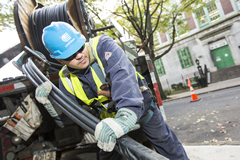 A new portable cable winch makes pulling cable easier and safer.
A new portable cable winch makes pulling cable easier and safer.
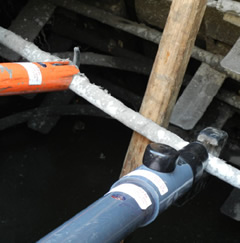 New equipment allows for better control, faster response time, and improved ease-of-use when cutting cable on active faults.
New equipment allows for better control, faster response time, and improved ease-of-use when cutting cable on active faults.
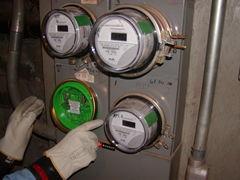 A meter-disconnect adapter so innovative that the U.S. Patent Office issued the company a patent for the design.
A meter-disconnect adapter so innovative that the U.S. Patent Office issued the company a patent for the design.
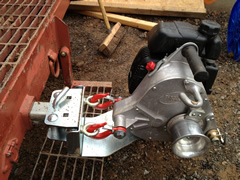 A simple and innovative solution that makes cable-pulling winch equipment smaller and more maneuverable.
A simple and innovative solution that makes cable-pulling winch equipment smaller and more maneuverable.
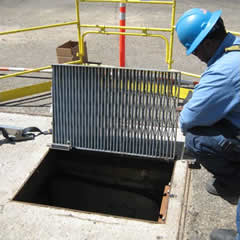 The spring-loaded vault door auto-latch helps eliminate an ongoing safety hazard to field employees.
The spring-loaded vault door auto-latch helps eliminate an ongoing safety hazard to field employees.
